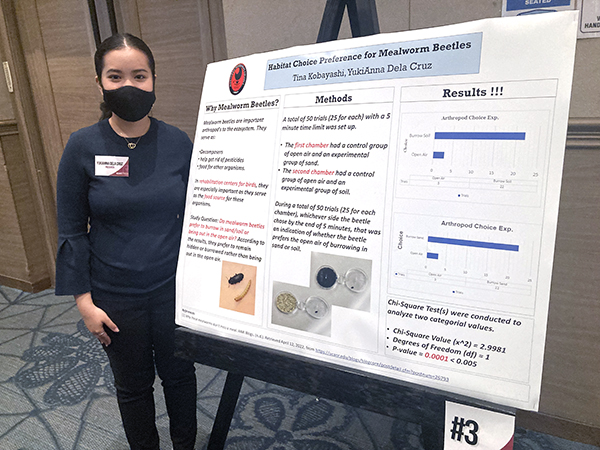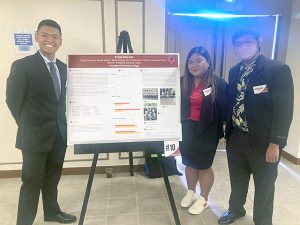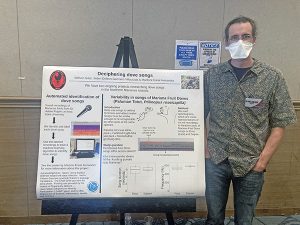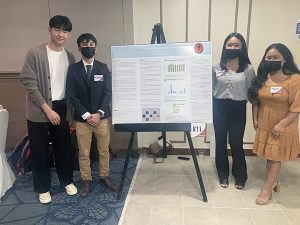Preparing brilliants minds for the CNMI’s future

Northern Mariana College student YukiAnna Dela Cruz presenting her research on Habitat Choice Preference for Mealworm Beetles at the 2nd Annual Research Symposium last April 29, at the Saipan World Resort’s Royal Taga Hall in Susupe. (Iva Maurin)
Given a choice between staying out in the open or burying itself in sand, mealworm beetles would rather remain hidden. Also, it turns out that a specific mixture of fresh manure, mashed bananas, and water can produce the most amount of biogas.
These amazing findings were shared at the 2nd Annual Research Symposium last April 29 at the Royal Taga Hall of the Saipan World Resort in Susupe, where Northern Mariana College students took center stage to present their findings and the results of their research in the fields of science, technology, agriculture, and engineering.
About 50 students, along with some faculty, gave poster presentations before a crowd of policy makers, educators, scientists, and environmentalists at the symposium, which was organized by Project PROA and the Sciences, Mathematics, Health & Athletics department of NMC.
Among the poster presentations centered on environment were “Trash Into Gas” by Daryll De Luna, Alyssa Galvez, Mark Galang, John Christopher Fabros, and Donavon Flores; “Habitat Preference for Mealworm Beetles” by Tina Kobayashi and YukiAnna Dela Cruz; “Soaking Up Sunshine” by Mateo Guerrero, Won Kim, Justine Nauta, Kaye Obando, and Jaydine Parico; and “Deciphering Dove Songs” by Dr. Willson Gaul, Jaden Deleon Guerrero Villacrusis, and Maritoni Frank Fernandez.
NMC president Dr. Galvin Deleon Guerrero, Ed.D., said that at the core of the college’s new strategic master plan is the value of stewardship, translated with the research symposium and academic programs using what they refer to as Stewardship through Scholarship.
“What we’re doing is we are helping equip our students with the research skills they need to solve the most difficult and pressing problems of our day, whether it be in the environment…the economy or…something broader in society. We evolve to take care of our people, our resources in our community,” Deleon Guerrero said.
Where can we find mealworm beetles?
Curious to find out where best to find mealworm beetles, De la Cruz conducted 50 trials where the insects were made to choose whether to stay out in the open air or bury themselves in sand or soil. The conclusion? The arthropod prefers to remain hidden or burrowed.
“Insects are very great examples to use because they very much help humans and they’re very much more evolved. Especially with the environment, they help as decomposers, they also help get rid of pesticides, and they also are food choices for other organisms, especially for birds,” De la Cruz told Saipan Tribune.

Northern Mariana College students Daryll De Luna, Alussa Galvez, and Mark Galang entertain questions from the guests interested in their research, Trash to Gas, at the 2nd Annual Research Symposium last April 29, at the Saipan World Resort’s Royal Taga Hall in Susupe. (Iva Maurin)
De la Cruz’s professor did find some of the beetles on the sidewalk of the American Memorial Park, she found in her research that the beetles like to be hidden in the sand and soil. In the poster, De la Cruz and Kobayashi noted that aside tom being decomposers and food for other organisms, mealworm beetles also help get rid of pesticides.
“Once we analyzed all of our data, we found that they made the conscious decision of choosing the sand or the soil instead of just being out in the open. …By observing their behavior, we can use this as a way for us to figure out: Can we use this as a way to get rid of pesticides?”
Finding an alternative source of fuel
Looking to find alternative sources of fuel on island, especially with gas prices going up, the student researchers chose to study biogas production with livestock, experimenting with cow manure and mixing it with vegetable peelings or mashed bananas to see which mixture produces the most gas.
“Is it possible here on Saipan? It turns out yes, it is possible. You just need cow manure and biomass. If you mix those two together with water inside of a container and let it ferment for a few days, you can harvest biogas,” De Luna told Saipan Tribune.

Northern Mariana College Biology professor Dr. Willson Gaul presents the results of a research on deciphering dove songs at the 2nd Annual Research Symposium last April 29, at the Saipan World Resort’s Royal Taga Hall in Susupe. He worked on this research alongside Jaden Deleon Guerrero Villacrusis and Maritoni Frank Fernandez. (Iva Maurin)
Galvez explained that using balloons, and a mixture of 28 grams of cow manure, 28 grams of vegetable peelings/mashed bananas, and water placed in bottles, they were able to identify which mixture gave the most successful outcome, that is, the manure mixed with mashed bananas and water. The students also noted that they were able to successfully produce gas using fresh and semi-fresh manure, compared with day-old ones.
“Biogas contains methane, which is the base of our everyday fuel—the fuel that we use in cars and so on, so forth. We know that biogas can be a reliable source of fuel, it’s just a matter of harvesting it.”
The students emphasized that manure—given that they can be easily collected in cattle farms—can be an alternative energy source for livestock farmers.
Color choices as the island warms up
Experimenting with the power of the sun and how it affects day-to-day life on island, the students researched on how colors impact heat. Using colored construction papers, an infrared thermometer, and the sun, the group concluded that darker colors emit and absorb more radiant energy than lighter ones.
“We hypothesized that darker colors absorb the most amount of heat and lighter colors the least amount,” Nauta said. “We placed 4”x4” colored construction papers, took its temperature, transferred it on a light colored surface, and put it under the sunlight. After a minute, we take its temperature again. Our findings were consistent with the hypothesis because darker colors did absorb the most amount of heat,” she said.
“Sunlight carries energy and as soon as it reaches a surface such as your shirt, it will be absorbed and transferred into heat. This study was conducted to replicate previous findings that determine how high the amount of radiant energy is absorbed and affected by an item’s color,” she added.

“Soaking Up Sunshine” researchers Won Kim, Mateo Guerrero, Jaydine Parico, and Justine Nauta present their study on how energy from the sun gets absorbed by colors. Kaye Obando not in photo. (Iva Maurin)
The group also related their study to climate change, adding that as it gets hotter in the CNMI, the project will prove practical not just in people’s clothing choices, but also in terms of the construction and design of buildings in the future.
Using technology to identify bird songs
With the government working to secure the future of endemic birds through translocation, research is also being done at NMC on the possibility of using apps to automatically identify bird songs.
NMC pre-engineering student Maritoni Fernandez said that, by using the app Audacity, she is building a spectrogram—a visual representations of sound recordings—of bird songs, using sound recordings from Dr. Halter Rogers of Iowa State University, particularly of the White-Throated Ground Dove, Philippine Collared Dove, and the Marianas Fruit Dove.
“This [research] basically helps us understand the types of doves we have on our island, and be able to have more knowledge on them, and know the population that’s currently on Saipan, Rota, and Tinian, and hopefully, the Northern Islands,” she said.
The Department of Fish and Wildlife has a long-term project to translocating bird species to the Northern Islands, including the Mariana Fruit Dove, but sending people to the islands to keep checking on the birds is logistically very demanding.
“What we would love to be able to do is put a microphone and a sound recorder up on the Northern Islands and leave it there all year and then come back a year later and pick up the sound recordings and use that to study how the birds have been doing,” said Gaul, a Biology professor at NMC who is working with Fernandez on the research.
“The problem with that is if you leave a sound recorder up there all year, you’re going to have thousands of hours of sound recording—way too much for a person to listen to on their own. But if we can get a computer that is able to identify the bird sounds in that recording, then we could analyze thousands of hours from the Northern Islands easily,” he added.
Aside from the automated identification of dove songs, Gaul is also working on another research about the variability in songs of Mariana Fruit Doves across the islands.



























